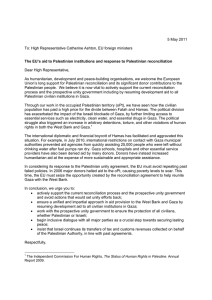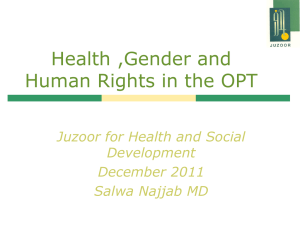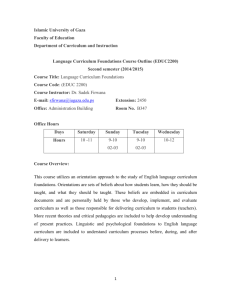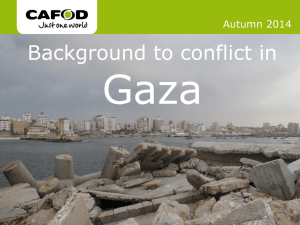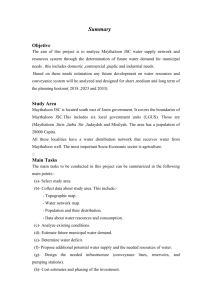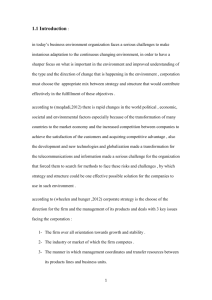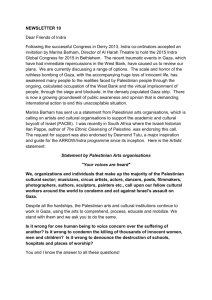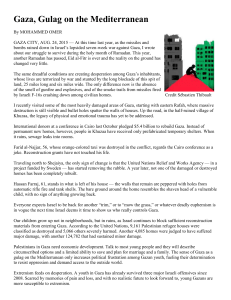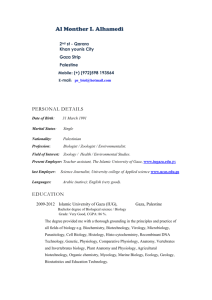PROJECT INFORMATION DOCUMENT (PID) APPRAISAL STAGE
advertisement
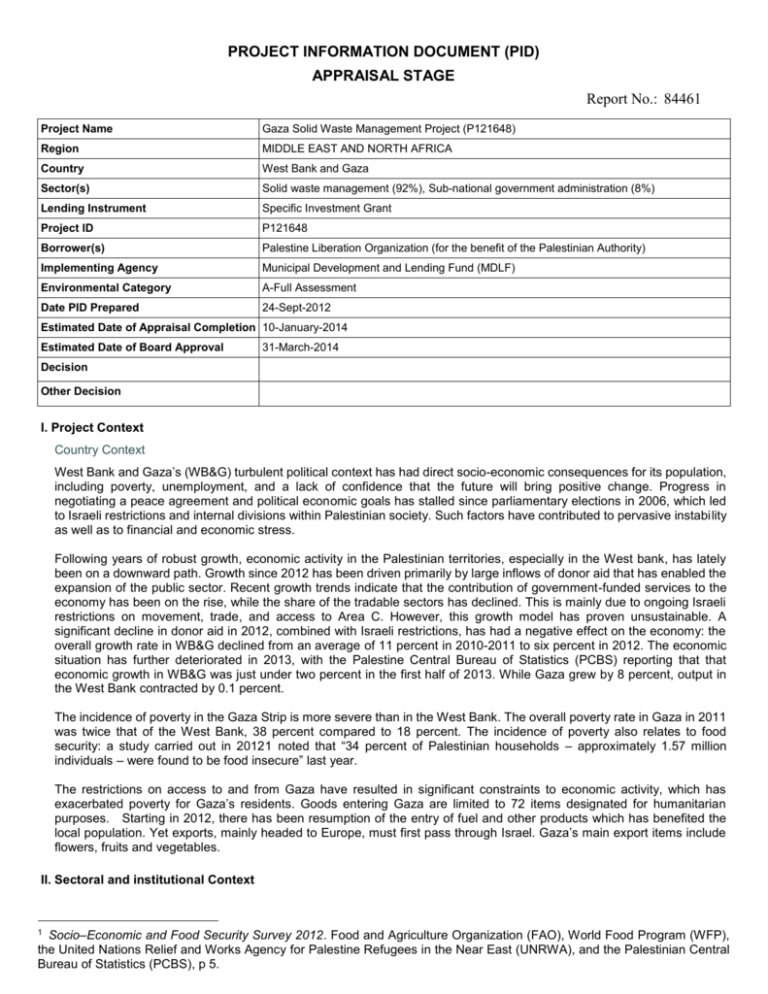
. PROJECT INFORMATION DOCUMENT (PID) APPRAISAL STAGE Report No.: 84461 . Project Name Gaza Solid Waste Management Project (P121648) Region MIDDLE EAST AND NORTH AFRICA Country West Bank and Gaza Sector(s) Solid waste management (92%), Sub-national government administration (8%) Lending Instrument Specific Investment Grant Project ID P121648 Borrower(s) Palestine Liberation Organization (for the benefit of the Palestinian Authority) Implementing Agency Municipal Development and Lending Fund (MDLF) Environmental Category A-Full Assessment Date PID Prepared 24-Sept-2012 Estimated Date of Appraisal Completion 10-January-2014 Estimated Date of Board Approval 31-March-2014 Decision Other Decision . I. Project Context Country Context West Bank and Gaza’s (WB&G) turbulent political context has had direct socio-economic consequences for its population, including poverty, unemployment, and a lack of confidence that the future will bring positive change. Progress in negotiating a peace agreement and political economic goals has stalled since parliamentary elections in 2006, which led to Israeli restrictions and internal divisions within Palestinian society. Such factors have contributed to pervasive instability as well as to financial and economic stress. Following years of robust growth, economic activity in the Palestinian territories, especially in the West bank, has lately been on a downward path. Growth since 2012 has been driven primarily by large inflows of donor aid that has enabled the expansion of the public sector. Recent growth trends indicate that the contribution of government-funded services to the economy has been on the rise, while the share of the tradable sectors has declined. This is mainly due to ongoing Israeli restrictions on movement, trade, and access to Area C. However, this growth model has proven unsustainable. A significant decline in donor aid in 2012, combined with Israeli restrictions, has had a negative effect on the economy: the overall growth rate in WB&G declined from an average of 11 percent in 2010-2011 to six percent in 2012. The economic situation has further deteriorated in 2013, with the Palestine Central Bureau of Statistics (PCBS) reporting that that economic growth in WB&G was just under two percent in the first half of 2013. While Gaza grew by 8 percent, output in the West Bank contracted by 0.1 percent. The incidence of poverty in the Gaza Strip is more severe than in the West Bank. The overall poverty rate in Gaza in 2011 was twice that of the West Bank, 38 percent compared to 18 percent. The incidence of poverty also relates to food security: a study carried out in 20121 noted that “34 percent of Palestinian households – approximately 1.57 million individuals – were found to be food insecure” last year. The restrictions on access to and from Gaza have resulted in significant constraints to economic activity, which has exacerbated poverty for Gaza’s residents. Goods entering Gaza are limited to 72 items designated for humanitarian purposes. Starting in 2012, there has been resumption of the entry of fuel and other products which has benefited the local population. Yet exports, mainly headed to Europe, must first pass through Israel. Gaza’s main export items include flowers, fruits and vegetables. . II. Sectoral and institutional Context 1 Socio–Economic and Food Security Survey 2012. Food and Agriculture Organization (FAO), World Food Program (WFP), the United Nations Relief and Works Agency for Palestine Refugees in the Near East (UNRWA), and the Palestinian Central Bureau of Statistics (PCBS), p 5. The Solid Waste Sector The generation and disposal of solid waste in the WBG is now well recognized development concern. The volumes of waste generated are high. The Palestinian Central Bureau of Statistics (PCBS) and the Palestinian Authority’s (PA) National Strategy for Solid Waste Management have estimated that during the 2010-2014 period, about 78,644 tons of solid waste will be generated per month. At the household level, daily domestic waste generation is high: an average household generates about 3.5 kg of waste, with higher amounts for the West Bank of 3.9 kg, and 2.7 kg for the GS. The West Bank has made major strides in solid waste management (SWM): the northern landfill (Jenin), operational since July 2007, was completed under the auspices of the Solid Waste and Environmental Management Project (SWEMP2). A similar landfill is being constructed to serve the Bethlehem and Hebron Governorates through the on-going Southern West Bank Solid Waste Management Project (SWMP)3 and is expected to be operational in April 2013. For the middle area, a sanitary landfill is in the planning phase. Institutionally, the Jenin Joint Services Council (JSC) was established. Following construction of the Jenin landfill, there have been notable improvements in the management of solid waste systems in the northern West Bank. Beyond its mandate, the JSC has launched a recycling program (from September 2011) in partnership with the private sector 4 with fee-based disposal services for municipalities that are not members of the JSC. The Jenin JSC model has been replicated in the case of the Hebron-Bethlehem JSC for SWM. The Gaza Strip (GS)5 Unlike the West Bank, the situation in GS faces greater technical, environmental, social, institutional and financial challenges. The GS covers an area of about 365 km 2, approximately 40 km in length and 7 to 10 km in width. Gaza city is considered one of the most densely populated places on earth with approximately 4,380 persons per km 2. In 2011, the population of about 1.6 million generated a solid waste load of about 1,500 tons per day (or about 550,000 tons per year). The population is expected to increase to about 2.08 million by 2020 implying solid waste generation of about 2,094 tons of waste per day, and reaching an estimated 3,400 tons per day by 2040. In line with other public services, SWM is under extreme stress in the GS due in large measure to the GOI closure of the area which has, among other effects, led to a waste collection and disposal system that is highly fragmented and poorly managed6, and that does not meet basic public health and environmental criteria. Furthermore, the capacity of waste management service providers is weak, and the general impoverished economic circumstances of the Gaza population have led to an inability or reluctance to pay for basic collection and disposal services. Primary Collection. In GS, primary collection is the responsibility of the 33 municipalities. Collection practices vary: in densely populated neighborhoods, daily house to house collection is the norm; in busy commercial areas, collection can occur twice daily; however, in less densely built-up areas, waste is collected from street containers 2-3 times per week. According to the project feasibility study the existing primary collection methods present several operational and financial challenges: 2 Collection is often performed by donkey carts 7 which impacts the efficiency and affects the safety and well-being of the animals. Waste collection using animal carts is undertaken by private operators contributing to a fragmented and ad-hoc waste collection system.8 The waste collection fleet is old and in need of replacement.9 A World Bank US$9.42 million credit that sought to improve waste management in the Jenin District by: building a sanitary landfill, rehabilitating and closing uncontrolled dumps, and improving SWM services through provision of equipment, training and capacity-building within the JSC. 3 A World Bank US$12 million grant aims to improve disposal services in the Bethlehem and Hebron Governorates. The project includes capacity-building for the JSC, construction of a sanitary landfill and a public awareness campaign to promote waste minimization, resource recovery and cost recovery. 4 The total daily waste load entering the landfill is about 700 tons of which 10-15% would be reclaimed as organic components for composting, and the rest would reclaim 10 tons/day of cartons, 1 ton/day of metals and 5 tons/day of plastics for recycling. The recycling of non-organic materials is a function of the market demand. 5 The information presented here is based on the Feasibility Study and Detailed Design for Short-Term and Long-Term Solid Waste Management in the Gaza Strip, UNDP-PAPP, January 2012, prepared by DHV and Partners. The study was undertaken over the 12-month period as of May 2011. 6 Among others, these restrictions affected the import of new solid waste equipment. 7 some 260 donkey carts in Gaza Municipality alone 8 Although there is scanty information on the condition of existing waste collection equipment, detailed studies are needed to better design a cost-effective system; no information on the age and health of the animals used nor on the condition of the carts. Observations during field visits have given the impression that the carts are in need of repair and the animals are generally old and overworked. 9 Currently, there are 10 waste compactor trucks warehoused in the West Bank which have been imported by UNDP since 2010. However, Israel has blocked their entry into Gaza. To compensate for the lack of compactors and to generate employment for vulnerable groups Residents are either reluctant or refuse to pay for services, often due to poor collection. The issue of “free riders”, especially those able to pay needs to be systematically addressed. Solid waste collection and disposal represent the largest cost in municipal budgets10 who often rely on subsidies received from the PA and donors. Due to the complexity of primary collection issues, it has been necessary to carry out detailed neighborhood and community studies, complemented by community consultations, to design an affordable and cost-effective system.11 Disposal. GS has three legally designated landfill and seven random dump sites. These include: Johr Al-Deek in the north, operated by the Gaza municipality, Deir El-Balah in the middle area, operated by the Deir El-Balah JSC, and Al-Fukhari (Sofa) in the south, operated by Rafah municipality. Of the three, only Deir El-Balah meets the international sanitary criteria of landfills. This landfill, built in 1995 with German assistance, has now reached its maximum capacity as have the remaining two landfills. As for the random dumpsites, these are poorly maintained sites across the GS. Institutionally. There are five solid waste disposal management service providers in the GS, as follows: The Northern Gaza JSC serves four municipalities in the Northern Gaza Strip. Gaza municipality manages solid waste within its jurisdiction. The Deir El-Balah JSC serves the 13 municipalities and villages in the middle strip. The Rafah JSC serves three municipalities around the Rafah Municipality. The Rafah municipality manages its own solid waste. The United Nations Relief and Works Agency (UNRWA) provides SWM services free of charge in eight refugee camps located throughout the GS, and uses the existing JSC and municipal facilities for disposal purposes. Within this context, the following are priorities for the GS: Improving collection and sanitary disposal capacity and performance. Improving cost recovery through strengthening collection and disposal institutions. Acquiring the necessary and appropriately located land for the construction of new facilities and/or for the expansion of existing sanitary landfills. Building public awareness. Observing current Israeli disposal location criteria. Securing the required financing to fulfill above actions. The project’s feasibility study, commissioned by the PA, was set to examine three possible scenarios to meet the projected solid waste loads through 2040. Following extensive consultations with key stakeholders 12, consensus was reached to focus on municipal waste collection and disposal, and to pilot waste recovery schemes. Agreement was also reached to construct two sanitary landfills in the Northern and Southern GS. Programmatic Approach. Because SWM in GS poses some special challenges noted above, there was agreement that addressing these challenges will require several sustained interventions over many years. For these reasons, it was agreed with key stakeholders that a programmatic approach 13 involving the development of two separate but closely related and coordinated projects would be more effective than a single large project. Several donors have expressed readiness to provide the needed funding. . III. Project Development Objectives The objective of the Project is to improve solid waste management services in the Gaza Strip. . IV. Project Description Component Name external support have facilitated the import of donkeys and funded local production of waste collection carts. Such support to municipalities has been funded by UNDP, MDLF and NGOs as temporary employment programs. 10 The Environmental and Social Impact Assessment (ESIA) reported that current fees for solid waste collection per household represent a high proportion of household budgets, although still within the World Bank standards of 1-3% of household expenditures. The ESIA also reported that household income is variable and unreliable as most jobs are temporary. 11 The feasibility study and the ESIA reported that beneficiaries consider (a) solid waste disposal a lower priority than provision of water, electricity and sewage disposal; (b) primary collection is of greater importance than final disposal; (c) the quality of primary collection is inadequate and thus not willing to pay for collection services; (d) the cost of solid waste collection and disposal is too expensive; and (e) the use of donkey- and horse-driven carts for primary collection is ineffective and should be discontinued. 12 Including government authorities (Ministries of Local Government and Environmental Affairs), municipalities, JSCs and related stakeholders; and donor partners (Agence Française de Développement (AFD), European Union (EU), and the Islamic Development Bank (IsDB)), UNDP and World Bank 13 The proposed programmatic approach is mainly distinguished from a fully integrated program involving a single implementing agency. Component 1: Solid Waste Transfer and Disposal Facilities Component 2: Institutional Strengthening Component 3: Primary Collection and Resource Recovery Component 4: Project Management . V. Financing (in USD Million) For Loans/Credits/Others Amount Borrower 2.10 European Commission France (French Agency for Development) 6.48 13.64 Sweden, Government of Special Financing 0.64 10.00 Islamic Development Fund /UNRWA 0.80 UNDP-DEEP 1.60 Financing Gap 0.00 Total 35.26 . VI. Implementation A. Institutional and Implementation Arrangements14 Given the specific institutional and implementation challenges expected for the GS, a programmatic approach for developing two separate projects was agreed among key stakeholders as the most effective option over a single large project. Therefore it was agreed that the Bank and co-financing partners would focus resources on the Khan Younis, Rafah and Middle Area of the GS project (KRM SWMP), while UNDP and their co-financing partners would focus on the Gaza Municipality and North Gaza (GNG SWMP) especially given that the UNDP15, with support from Japan and IsDB, supports collection and disposal issues in Gaza and North Gaza. The implementation strategy for this project is as follows: (a) Build on the lessons from similar projects implemented in the WBG; (b) Assign MDLF as the implementing entity to ensure compliance with World Bank fiduciary and safeguard requirements; among other duties; (c) Recruit consultants to oversee the landfill construction at Al-Fukhari (Sofa) in southern GS and to ensure contractors’ compliance with commissioning requirements - and with - the participation of the JSC-KRM; (d) Develop the technical and managerial capacities of the JSC-KRM-TOU; (e) Adopt a programmatic approach comprising two main projects; and (f) Establish a SWM Development Committee to provide overall strategic guidance for the sector in Gaza to oversee and the implementation of both projects. B. Results Monitoring and Evaluation (M&E) MDLF, through its established PDSU, would be responsible for overall project implementation including monitoring and evaluation, and preparing technical and financial progress reports. The PDSU supported by the JSC-KRM, will oversee data aggregation and periodic reporting on progress, and ensure that the PDO is met. The PDSU will maintain an M&E arrangement, including auxiliary data storage tools for data collection, output dashboards and outcome monitoring, reporting, and evaluation of project performance. Environmental and social data, including compliance with the Environmental Management Plan (EMP) and Resettlement Action Plan (RAP), will be provided through independent consultants and Ministry of Environmental Affairs monitoring, as proposed in Annex 1. Monitoring the technical aspects of construction contracts under Component 1 will be carried out by independent consultants to be contracted by the project. . VII. Safeguard Policies (including public consultation) Safeguard Policies Triggered by the Project 14 Yes No The institutional arrangements are presented in details charts in Annex 3. While UNDP has been actively involved in supporting SWM feasibility, the participation of other implementing agencies has not been ruled out. 15 Environmental Assessment OP/BP 4.01 Natural Habitats OP/BP 4.04 X Forests OP/BP 4.36 X Pest Management OP 4.09 X Physical Cultural Resources OP/BP 4.11 X Indigenous Peoples OP/BP 4.10 X Involuntary Resettlement OP/BP 4.12 X Safety of Dams OP/BP 4.37 X Projects on International Waterways OP/BP 7.50 X Projects in Disputed Areas OP/BP 7.60 X . VIII. Contact point World Bank Contact: Ibrahim Khalil Dajani Title: Senior Operations Officer Tel: 5366+241 / +972 2 236 6500 Email: idajani@worldbank.org . Borrower/Client/Recipient Name: Palestine Liberation Organization (for the benefit of the Palestinian Authority) Contact: Dr. Shukri Bishara Title: Minister of Finance Tel: +972 2 297 8842 Email: mofirdg@palnet.com . . Implementing Agencies Name: Municipal Development and Lending Fund Contact: Abdel Moghni Nofal Title: General Director Tel: +972 2 296 6610 Email: anofal@mdlf.org.ps . . IX. X For more information contact: The InfoShop The World Bank 1818 H Street, NW Washington, D.C. 20433 Telephone: (202) 458-4500 Fax: (202) 522-1500 Web: http://www.worldbank.org/infoshop
